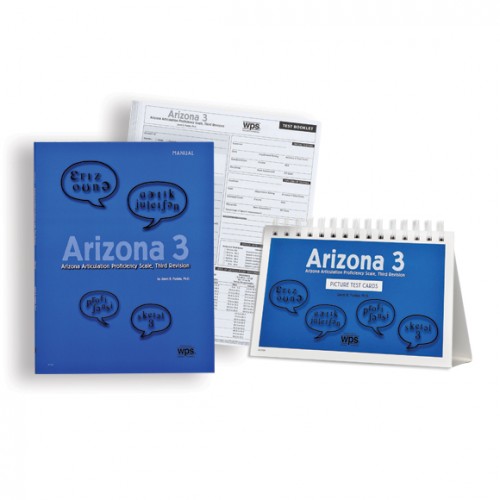Arizona Articulation Proficiency Scale (ARIZONA-3)
Complete Kit
- Ages 1.5 through 18 years
- Testing Time 3 minutes or less
- Administration Individual
-
Product Code W-358 ( MR #050408 )
* Qualifications required to purchase this item. Click here to complete the qualifications form.
* Regional restriction: This item is only available for sale within Canada.
*DISCONTINUED (*NEW EDITION in Alternatives below)
All Major Speech Sounds Assessed in Less Than 3 Minutes
Comprehensive, simple, and brief, the Arizona-3 covers all major speech sounds in the English language, including initial and final consonants and blends, vowels, and diphthongs. All target sounds are tested with just 42 cards—in less than 3 minutes. The test generates a clear-cut Total Score that indicates severity of articulatory deviation.
Simple, Quantitative Scoring Rules
The examiner displays spiral-bound Picture Cards, one at a time, and the child names the object depicted on each card. The examiner listens for particular consonants and vowels and then scores the child’s response according to simple, quantitative rules.
Arizona-3 scores are provided in several formats—intelligibility descriptions, severity designations, percentile rankings, and standardized scores (Z-scores, standard scores, and normal curve equivalents). This allows you to select the kind of score that’s most meaningful for a specific assessment purpose.
A Convenient Test Booklet
To simplify test interpretation, the Arizona-3 Test Booklet includes both Intelligibility and Severity Ratings. It provides room for notes and programming recommendations and lists the ages at which 90% of all children achieve mastery of each sound assessed.
Gender-Specific Norms
The Arizona-3 was standardized on a national sample of more than 5,500 children and teens. The sample represents the U.S. population in terms of ethnicity, region, and parental education, and it includes equal numbers of boys and girls. Norms are gender specific up to age 6—which is helpful during the preschool years, when boys and girls tend to develop speech and language skills at different rates.
Three Optional Assessment Tasks
The Arizona-3 includes three optional tasks that enhance its clinical usefulness. With the exception of the Word Reading Administration option, which is an alternate method for administering the standard Articulation Test, these tasks are not standardized or scored. The Language Screening and Spontaneous Speech tasks enhance your evaluation by allowing you to sample spontaneous speech and form an impression of overall language skills.
Word Reading Administration
Examinees can read target words rather than naming objects on the Picture Cards. Teenagers are often more comfortable with this option. And it’s useful with head injury patients, who may have naming deficits but are still able to read.
Language Screening Task
On the back of almost every Picture Card is a follow-up question that can be used to elicit information about the examinee’s vocabulary and language-based cognitive skills. Since typical answers for various age levels are also printed on the Cards, you can quickly note whether or not the child has reached a particular developmental milestone.
Spontaneous Speech Task
Two additional Picture Cards encourage spontaneous conversation. You can use these to obtain a sample of continuous speech and analyze it for vocabulary, mean length of utterance, and other aspects of language development.
Quick, reliable, and objective, the Arizona-3 exceeds the exacting federal and state regulations concerning measurement for special education placement. It’s an ideal way to quickly assess articulation proficiency, select children for speech therapy, measure treatment progress, and explain language competencies to parents, teachers, and other professionals.

 Proud to be Canadian
Proud to be Canadian
